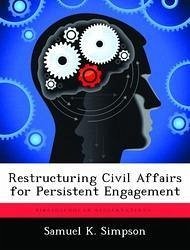Since the end of the Cold War, growing state and global instability, particularly in undergoverned regions of the world, has led to increasing requests from ambassadors and combatant commanders for civil affairs forces to conduct missions in support of a whole-of-government (WOG) approach aimed at improving and sustaining stability, and preventing war. More than ninety percent of the civil affairs force structure is in the U.S. Army Reserve in support of conventional forces, with only one brigade in the active component for special operations and contingency missions. Based on increasing government emphasis on persistent whole-of-government operations to maintain stability and protect U.S. interests, in addition to enduring counterinsurgency and foreign internal defense operations -of which civil military operations are a key component-the authorized growth in civil affairs forces will not meet the increasing demand. The purpose of this monograph is to discern an appropriate civil affairs force structure to conduct civil affairs operations in support of persistent whole-of-government stability, security, transition, and reconstruction (SSTR) efforts and support military forces in long-term full spectrum operations in Iraq, Afghanistan, the Philippines, and other undergoverned states in order to improve stability of the international state system. This monograph reviews existing literature on contemporary civil affairs; highlights the linkage between national strategy, doctrine and force requirements; analyzes demand for reserve and active duty civil affairs forces, proposes a macro-level demand model for determining special operations civil affairs force structure, compares current force structure to the modeled demand, and recommends changes in force structure to meet the demands of persistent conflict for the next two decades. The conclusion of this research is that the Department of Defense should increase and realign the force structure of the reserve and activ








